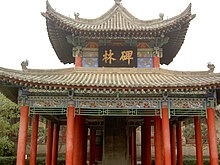| Guozijian | |||||||||||||||||
|---|---|---|---|---|---|---|---|---|---|---|---|---|---|---|---|---|---|
| Chinese name | |||||||||||||||||
| Traditional Chinese | 國子監 | ||||||||||||||||
| Simplified Chinese | 国子监 | ||||||||||||||||
| |||||||||||||||||
| Vietnamese name | |||||||||||||||||
| Vietnamese alphabet | Quốc tử giám | ||||||||||||||||
| Chữ Hán | 國子監 | ||||||||||||||||
| Korean name | |||||||||||||||||
| Hangul | 국자감 | ||||||||||||||||
| Hanja | 國子監 | ||||||||||||||||
| |||||||||||||||||
| Manchu name | |||||||||||||||||
| Manchu script | ᡤᡠᡵᡠᠨ ᡳ ᠵᡠᠰᡝ ᠪᡝ ᡥᡡᠸᠠᡧᠠᠪᡠᡵᡝ ᠶᠠᠮᡠᠨ | ||||||||||||||||
| Möllendorff | gurun-i juse be hūwašabure yamun | ||||||||||||||||




The Guozijian,[1] sometimes translated as the Imperial College, Imperial Academy, Imperial University, National Academy, or National University,[2] was the national central institution of higher learning in Chinese dynasties after the Sui dynasty. It was the highest institution of academic research and learning in China's traditional educational system, with the function of administration of education.
- ^ Yuan, 194.
- ^ Frederick W. Mote; Denis Twitchett (26 February 1988). The Cambridge History of China: Volume 7, The Ming Dynasty, 1368-1644. Cambridge University Press. pp. 131–. ISBN 978-0-521-24332-2.